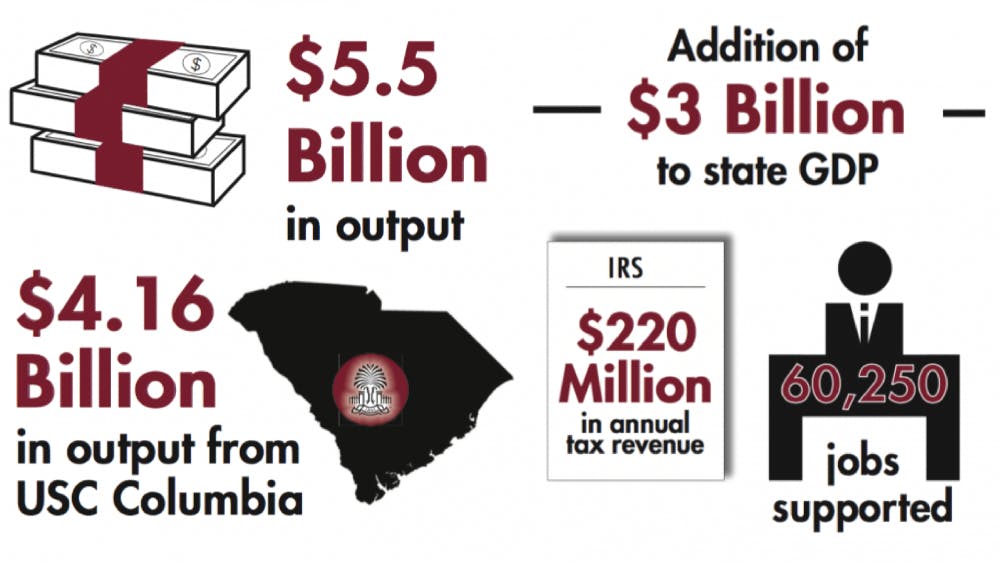The USC system makes an annual economic impact of more than $5 billion statewide, according a study released Aug. 14 by the Darla Moore School of Business.
Authored by Moore School research economist Joseph Von Nessen, the study looked into the economic impact of the USC system's 50,000 students and 180,000 in-state alumni. USC associate director for public relations Jeff Stensland said the study was commissioned as an update to a 2011 economic analysis and sought to prove USC's "tangible economic benefits to graduates, businesses and communities throughout South Carolina."
“The economic benefits of higher education are far reaching for both individual citizens and the state as a whole,” Von Nessen said in the study's release. “The lives of individual alumni are improved through earning higher wages and a lifetime of better job opportunities, while the community at large also benefits through economic spillover effects and a net increase in tax revenue for the state of South Carolina.”
Overall, the study found that the USC system provides an annual economic impact of $5.5 billion measured in state output and a net total of $3 billion to the state gross domestic product. Included in that is the $220 million USC generates in tax revenue each year.
Across eight schools from Spartanburg to Beaufort, the system also supports the employment of 60,250 South Carolinians, including 18,729 who work for USC directly.
In itself, USC Columbia supports 46,040 jobs and makes a total impact of $4.16 billion on the state economy each year. Both numbers are expected to make an appearance when USC begins to make financial requests for the 2018 state budget. State appropriations will comprise only 10.4 percent of the USC budget this fall, down from 10.5 percent last year and a far cry from 23 percent in 2007.
“This study once again demonstrates that higher education is unquestionably a worthy investment,” USC President Harris Pastides said in the release. “Supporting higher education is not part of a zero sum game — it benefits not only those earning their degrees, but also increases prosperity for the entire state and every citizen.”
Higher education funding is down 37 percent in South Carolina since 2008. At the same time, the portion of the USC Columbia budget funded by tuition and fees has ballooned to 48.8 percent.
Pastides' comment on prosperity for all citizens holds true to the study's findings on workers with low levels of education. Specifically, it was found that increases in the supply of college graduates affect wages across the economic spectrum, not just for those holding degrees.
Drawing from census data on USC alumni and information from the National Association of Colleges and Employers, the study found that for each 1 percent increase in the state supply of college graduates, high school dropouts around the state see their wages increase 1.9 percent, high school graduates 1.6 percent and college graduates themselves 0.4 percent.
Addressing how college-educated workers increase wages across their region's economic spectrum, the study says the "most common" explanation for increasing wages is the "sharing of knowledge and skills in both formal and informal settings across workers."
Expanding upon the extent of USC's social returns, the study notes that "a more highly educated population is associated with nonfinancial benefits, such as increased voting and volunteering, better health, and improved child educational attainment."
The study also found a significant discrepancy between the economic well-being of college graduates and non-graduates in the state. 16.3 percent of South Carolina citizens without post-high school education live in poverty. Comparatively, the poverty rate for South Carolinians with at least a bachelor's degree is only 4.4 percent. An $18,000 gap in income rests between South Carolinians with a bachelor's degree and those with only a high school education.
Aside from the academic aspect of USC's impact, the study found that the system's athletic programs support 2,787 jobs and contribute nearly $225 million to the state economy each year.

